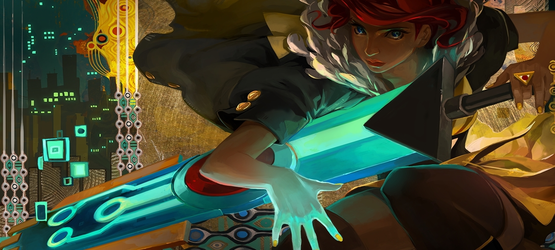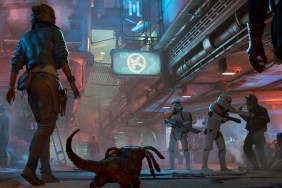I didn’t turn on my PS4 and start up Transistor expecting to have all my sci-fi action RPG needs satisfied in a single, breathtaking, artistic flourish. Heavy, hidden emotion throughout the entire experience makes you forget yourself and sink into the story. Enemies, gameplay, music, environment, and characters are all painted with this same deep hue.
Let me first talk about the connecting theme for all elements of this game– the art style. I can see heavy influences from the Art Deco period (during the Roaring Twenties in the U.S.). I love this period of art, and I was delighted to see Supergiant Games’ modern translation of it in Transistor. A lot of thought went into this modern Art Deco motif and I was constantly impressed and in awe during my journey through the game. One good example of the skill with which this was pulled off is the OVC Terminal (the ever-present social internet, accessible via kiosk). The interface uses Art Deco swirls on the screen tied in with modern internet text design. How can an old earthy art style be used with such a sci-fi theme? Transistor pulls it off. The digital painting that makes up the entire world, which is presented in a fixed camera style, is dramatic with its colors, and leads the eye with flowing lines characteristic of Art Deco and even Art Nouveau styles. Buildings and public works are set up close together in an organized way that lends the feel of a futuristic, highly functioning society, almost like a well oiled machine, yet the architecture is reminiscent of the Roaring Twenties with that modern flare that is so impressive in Transistor.
The next wondrous part you get to enjoy in Transistor is the music. At the time I was playing the game for review, I wanted to buy the soundtrack immediately, and was sad that I couldn’t have it until it officially released. I was (and still am) prepared to impulse-buy this soundtrack, even before finishing the game. The main character, Red, is a professional singer and you get to hear a few songs of hers, with hauntingly powerful vocals by Ashley Barrett. Also, after a while you get the ability to stop and hum. Literally, Red stops, hugs Transistor (her sword and companion), and hums along soulfully to whatever song is playing in the current environment. It’s a nostalgic moment’s reprieve from the dark trials Red faces throughout the journey, as Red lost her voice (or just her ability to speak–I think this a purposefully mysterious element of the story) in the events prior to the start of the game. I’ve never heard such emotive humming! Overall the soundtrack is raw, melancholic, and beautiful, just like Red and her story.
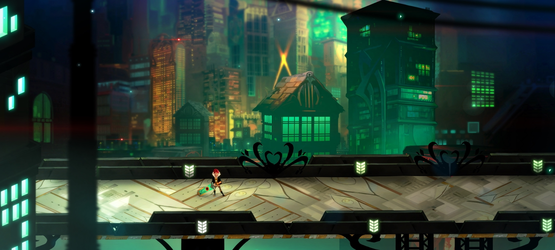
The environment in Transistor reflects very similar qualities to the soundtrack– it’s dark, industrial, and has a flowing life-like energy to it. In the story, the people that live in the city you explore have evacuated or fled the area, and you feel very lonely. Small human details like obvious apartment balconies, storefronts, peaceful public plazas, and city greenery make you feel like you just missed the people who live there–if only you’d been a moment earlier. You learn that the society in the game gets to vote on what weather to have each day, as well as the color of the sky. Different districts and neighborhoods do not fail to be varied and styled in their own way. Some are more grungy, and some are more futuristic; Some are more residential, and yet others are more commercial. Most of the places you go feel like secret side streets– cozy and detailed. This is partially due to the fixed-camera limiting spatial exploration, but the detail that went into the city is impressive.
To go along with the impromptu humming ability, you can also do a “flourish” at any time, which is a cool little animation of Red throwing Transistor in the air and doing a little jump and spin to catch it again. Some scenic or unique points in the world can be interacted with, which prompts Transistor to say something about that spot. These little details make the world pretty satisfying. However, at the beginning of the game, the developers used small environmental puzzles of sorts to teach you how to play. I missed these after that initial learning period. Small realistic puzzles throughout the entire journey would have made that bright-eyed wondrous feeling of interacting with the city shine through at 100% to the end, although I only realized it had diminished when I started my second playthrough and had fun doing the puzzles again.
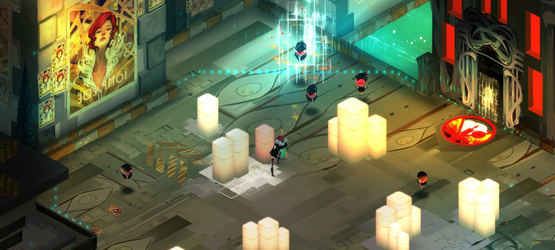
I can’t stop thinking about the story of Transistor, even after finishing the game. There is so much mystery and intrigue that left me smiling. This title has a good dose of mystery that doesn’t get completely ruined by the end of the game (mystery is no longer mysterious if you learn all the secrets), yet the game satisfies you with a meaningful ending. If you can’t handle that kind of pondering, you may not enjoy this game’s story style, but I thoroughly appreciate being trusted with concluding my own meanings and feelings about my experience with Transistor. I could say this game is a love story. Or I could say this game is about finding your own voice among too many. Either way, the story is very deep and satisfying to my brain and my heart.
A hugely intriguing part of the story of Transistor is the many varying characters. Most of them you only deal with indirectly, but the two main characters are very well personified, especially Transistor. He is the voice of this game. He is Transistor. I strongly recommend that you immediately enable the setting that lets Transistor’s voice come through the PS4 controller’s speaker. This totally immerses you in the game. You feel like you are Red, without a voice, traveling through the world with the most comforting voice as a companion that you can imagine in such a situation–Transistor’s voice. His voice comes through the controller and then echoes in surround sound (if you’re lucky enough to have that set-up). It’s pretty stunning. Also, enabling this option ensures you don’t miss any of what he says. You wouldn’t want to miss it, as his voice is so natural and reassuring, but also because the narration of this character is very important to playing the game. He says such conversational and spontaneous things that you don’t want to miss any of them. When I first started up the game I was saying things out loud like, “Whoa, it’s so pretty!” and accidentally drowned out the voice of Transistor. I shut my mouth after that.
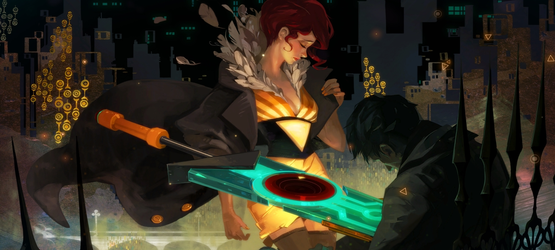
The other characters come to you slightly under the radar, but take my advice and do not ignore the opportunities to learn more about them, or you risk wasting such a creative atmosphere. When you level up, you get more powers called “functions” to use when customizing your battle loadout. When hovering over each ability, you can choose to “inspect function”. This brings you to a decrypted file describing the “trace data” for that function. A trace is a soul! Each “function” is materialized out of a person’s soul, whether alive or dead. It kind of lends an immortality to the characters. On this screen there is a surprisingly nuanced description of the person whose trace you are using. You can even unlock more of each person’s file by using that function as an attack, an upgrade to another attack, or as a passive effect for Red, totalling three parts per character you get to unlock and indulge in. I especially enjoyed seeing each character’s actual illustration in this menu. Each person is very much their own. They come from all walks of society, are all ages and genders, and are all important parts needed to unravel the intricate, obscured story of Transistor.
Last but not least, I need to tell you about the actual gameplay. The developers have created a magnificent action RPG battle system. If you like shooting things in real time, you can do that. If you want a bit of an advantage with a little more planning involved, you can have that too. I am not familiar with any other battle system quite like this one. I had fun customizing my functions (which are pleasantly varied), and then using my physical positioning and movement to turn the battle in my favor. I often forgot that I could battle in real time as well, and in the thick of the battle that sometimes comes in handy.
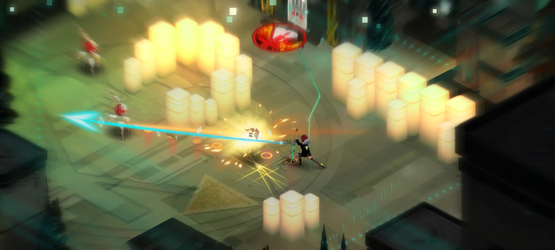
For those who like a challenge (like my husband, Chandler), Transistor has a custom difficulty modifier system that uses “limiters”. You get to select a new limiter to add to your arsenal each time you level up, as well as selecting a new function. These limiters give you more experience when in use, but they up the difficulty in different ways. For example, you can select the Initiative limiter, which makes the Process (enemies) respawn from cells in much less time (cells spawn from each enemy after you defeat it, but if you don’t go collect the cell in time, the enemy will respawn). There are ten different limiters that do various things to make the game harder, but the experience bonus adds up for every one you have in use. My gaming style is usually to go with the easiest difficulty first, to fully experience the story. The limiters system, however, encouraged even me to increase the difficulty due to the experience rewards and the fact that I could disable the limiters at any time. Transistor is made much more valuable with this type of difficulty system, in my opinion.
The entire game has a snowball effect when you play it. Each sparkly new facet knocks you over when you come upon it, and you get hit harder and harder as all the wonderful elements stack up. The art and music, the story, the environment, the gameplay, and the characters all tie back to each other in a way that I did not expect, and left me speechless when it culminated and the credits rolled. Maybe you noticed my review never touched on any detailed specifics regarding the story or the characters and how they fit in with each other, but that’s for good reason. Transistor is such a finely woven creation, I didn’t want to risk giving away any details and detracting from anyone’s personal experience of the game. I hope this fact can justly illustrate how great of a game it really is, and inspires you to want to play it as soon as you add more credits to your PSN wallet (which should be right now). I think just about anyone will enjoy at least some part of this title, if not thoroughly enjoy the whole. Give this game the time and love it deserves, as I can wholeheartedly say that a lot of time and love was put into creating it.
Editor’s Note – Check out our interview with Transistor’s Creative Director.
Review copy provided by developer. For information on scoring, please read our Review Policy here.
-
One-of-a-kind art style.
-
Inspiring, perfectly matched soundtrack.
-
Deep and emotional narrative.
-
Well-rounded cast of characters.
-
Fantastically fresh battle system.
-
There's even well-scripted humor!
-
Why can't I have environmental puzzles the whole way through my games?
